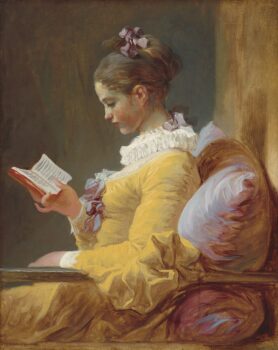Meaning of “A Young Girl Reading Painting” by Jean-Honoré Fragonard
In the world of Rococo art, few paintings capture the spirit of the era with such grace and subtlety as A Young Girl Reading by Jean-Honoré Fragonard. Painted around 1770, this work is a serene, tender portrayal of a young woman immersed in a book, lost in a moment of solitude and contemplation. On the surface, it seems like a simple genre painting,charming, graceful, and exquisitely rendered. But beneath this elegance lies a deeper narrative woven through symbolism, stylistic flourishes, and the personal artistic choices of Fragonard himself.
This essay delves into a comprehensive analysis of A Young Girl Reading, exploring how and why it was painted, its symbolic significance, the broader cultural context of the 18th century, and what this timeless piece reveals about femininity, education, and private introspection during the Rococo period. We’ll also examine the painting’s artistic style, technical execution, and its current place in the world of art history.
Jean-Honoré Fragonard: The Painter Behind the Masterpiece
Jean-Honoré Fragonard (1732–1806) was one of the leading painters of the Rococo period, known for his exuberant, sensuous, and often playful works. He was a master of brushwork and had a keen eye for intimate moments, favoring themes of romance, pleasure, and domestic leisure. Trained under François Boucher, another iconic Rococo artist, Fragonard developed a style that was opulent yet lighthearted, marked by pastel colors, fluid lines, and theatrical compositions.
Though Fragonard was primarily celebrated for his depictions of amorous encounters, such as The Swing and The Progress of Love series, he also had a more introspective side. A Young Girl Reading represents a quieter, more reflective moment in his oeuvre,one that diverges from his more sensual subjects and instead offers a poignant glimpse into personal tranquility.
Creation of the Painting: When, How, and Why
A Young Girl Reading is believed to have been painted around 1769–1772, during a prolific period in Fragonard’s career when he was experimenting with genre scenes and portraits. It is part of a group of paintings often referred to as his “figures de fantaisie,” or “fantasy figures”,a collection of quickly executed portraits that showcase both technical virtuosity and spontaneous energy.
Fragonard’s approach to this painting was improvisational, yet masterfully executed. X-ray analyses have revealed that the canvas underneath originally depicted a different composition, possibly a landscape or another portrait. This reuse of canvas was not uncommon, particularly among artists working rapidly or rethinking ideas.
Rendered in oil on canvas, the painting measures approximately 81.1 cm × 64.8 cm (32 in × 25.5 in), and its composition draws the viewer’s attention immediately to the young girl seated in profile. The smoothness of her skin, the folds of her vibrant saffron dress, and the softness of the background all contribute to an atmosphere of calm intimacy. Fragonard uses deft, expressive brushstrokes to create texture and lightness, especially noticeable in the rendering of the fabric and the girl’s hair.
What Is Happening in the Painting?
A girl, dressed in a bright lemon-yellow gown with white lace trim, sits in profile against a neutral background. She is deeply engrossed in a small book, holding it delicately in her right hand, with her left resting lightly in her lap. Her expression is calm, focused, and slightly dreamy,as though she is not merely reading but inhabiting the world within the book.
There are no elaborate props, no architectural backgrounds, and no external references to distract from the central figure. The painting centers on the girl’s interior world,an unusual and bold choice for an era that often valued drama, mythological allegory, and overt sensuality.
Symbolism and Deeper Meaning
Despite its apparent simplicity, A Young Girl Reading is rich with symbolic nuance and cultural commentary.
1. The Book as a Symbol
The most prominent symbol in the painting is the book. In 18th-century France, reading was both a sign of education and a private pleasure. Women were increasingly participating in intellectual life, and novels,particularly sentimental ones,were becoming immensely popular among female readers.
The book in the girl’s hand could represent:
Intellectual independence: Her engagement in reading highlights the growing visibility of literate women in Enlightenment Europe.
Inner life and imagination: The girl’s introspective gaze suggests a narrative unfolding within her mind, celebrating female subjectivity and autonomy.
Moral or emotional awakening: The 18th-century novel was often a vehicle for exploring virtue, love, and emotional sensibility,all themes that would have resonated with the painting’s contemporary viewers.
2. Color and Clothing
The yellow dress, vivid and eye-catching, could signify youthful energy and optimism. Yellow was often associated with creativity, joy, and enlightenment. The rich folds and sheen of the satin fabric showcase Fragonard’s mastery of texture and light, but they also emphasize the subject’s refinement and social status.
Her hairstyle, neat and contemporary for the time, also points to the conventions of Rococo beauty and femininity. However, it is restrained rather than extravagant,reinforcing the tone of quiet elegance rather than playful seduction.
3. Isolation and Introspection
Unlike many of Fragonard’s other paintings, there is no overt interaction or narrative tension in this image. The girl is alone, and her emotional world is turned inward. This emphasis on solitude can be interpreted as a celebration of private intellectual space,a revolutionary notion for women in the 18th century, who were often expected to exist in public, performative roles.
What the Painting Represents
A Young Girl Reading captures a pivotal cultural moment in European history,the rise of the Enlightenment and the shifting roles of women. During this period, education was becoming more accessible, and there was increasing debate about women’s place in society, particularly their right to knowledge and intellectual engagement.
Writers like Rousseau, Diderot, and Voltaire contributed to this discourse, while women such as Madame de Staël and Madame Geoffrin hosted salons that became centers of philosophical exchange. The painting echoes these social shifts by depicting a young woman not in the act of seduction, motherhood, or labor, but in the simple pleasure of reading,a quiet revolution in itself.
The subject’s youth suggests that education and personal reflection are valued from an early age, aligning with the Enlightenment ideals of progress and self-cultivation.
Artistic Style and Technical Analysis
A Young Girl Reading is a quintessential Rococo painting, though it hints at the introspective realism that would dominate later artistic movements.
Rococo Features:
Pastel palette: The painting uses soft, warm tones that evoke a dreamy, ethereal mood.
Brushwork: Fragonard’s loose, fluid strokes are both expressive and precise, especially in the rendering of the dress’s texture.
Focus on beauty and leisure: While more restrained than his typical works, it still celebrates a moment of pleasure,intellectual rather than sensual.
Departure from Rococo Excess:
Unlike some of Fragonard’s more ornate compositions, A Young Girl Reading shows minimalism in setting and composition. This indicates a maturation in his artistic vision and perhaps a response to changing tastes. As the Rococo style began to fall out of favor by the late 18th century, Fragonard adapted his approach, incorporating more intimate and contemplative scenes into his repertoire.
Reception
While the painting may not have been widely known in Fragonard’s own time,it was likely created for private commission or as a personal study,A Young Girl Reading has since become one of his most beloved and frequently reproduced works. Its quiet intimacy and universal subject continue to resonate with modern audiences.
The girl in the painting has also captured imaginations over centuries, with some speculation about her identity. Though unconfirmed, she is often believed to be Fragonard’s own sister-in-law, Marie-Émilie Marguerite Élisabeth Gabrielle, known as Marguerite Gérard, who was also a painter and Fragonard’s pupil. Whether or not this is true, the familiarity and tenderness with which she is depicted suggest a personal connection.
Where is the Painting Today?
A Young Girl Reading is currently housed in the National Gallery of Art in Washington, D.C., United States. It was acquired in 1961 from the Widener Collection and remains one of the gallery’s most prized pieces.
Its location in a major public institution ensures that it continues to inspire art lovers, scholars, and visitors from around the world. Its placement also marks a broader recognition of Fragonard not merely as a painter of frivolity, but as a master of emotional nuance and psychological depth.
Why A Young Girl Reading Still Matters
Jean-Honoré Fragonard’s A Young Girl Reading is far more than a pretty picture,it is a meditative exploration of solitude, knowledge, and the quiet power of the interior life. In a period often characterized by ornamental excess and theatricality, this painting stands out for its restraint and emotional clarity.
The girl, though unknown, becomes a symbol of an emerging cultural shift: the intellectual awakening of women, the celebration of personal reflection, and the elevation of everyday moments to the level of fine art.
By capturing a fleeting, introspective moment with such elegance and sensitivity, Fragonard created a timeless image,one that continues to speak across centuries about the joy of reading, the sanctity of solitude, and the silent strength of the human mind. As long as people seek beauty and meaning in art, A Young Girl Reading will remain a quiet but powerful voice in the gallery of cultural memory.




